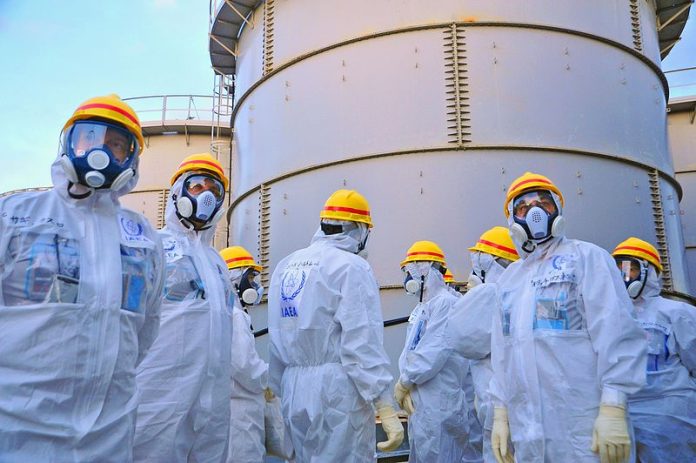International Atomic Energy Agency (IAEA) has confirmed that the tritium level in the fourth batch of diluted treated voda, which Tokyo Electric Power Company (TEPCO) started discharging on 28 February 2024, is far below the Japan’s operational limit.
Experts stationed at the site of the Fukushima nuklearna snaga station (FDNPS) took samples after the treated voda was diluted with morska voda in the discharge facilities on 28 February. The analysis confirmed that the tritium concentration is far below the operational limit of 1,500 becquerels per litre.
Japan is discharging the treated voda from the FDNPS in batches. The previous three batches – a total of 23,400 cubic metres of voda – were also confirmed by the IAEA to have contained tritium concentrations far below operational limits.
Since the accident in 2011, voda is needed to continually cool the melted fuel and fuel debris at the Fukushima Daiichi NPS. In addition to the voda pumped in for this purpose, groundwater also seeps into the site from the surrounding environment, and rainwater falls into the damaged reactor and turbine buildings. When voda comes in contact with melted fuel, fuel debris and other radioactive substances, it becomes contaminated.
The contaminated voda is treated through a filtration process known as Advanced Liquid Processing System (ALPS) which uses a series of chemical reactions to remove 62 radionuclides from contaminated water before being stored. However, tritium cannot be from the contaminated water through ALPS. Tritium can be recovered when it is highly concentrated in small amounts of water, for example at nuklearna fusion facilities. However, the stored water at the Fukushima Daiichi NPS has a low concentration of tritium in a large volume of water and so the existing technologies are not applicable.
Tritium is a naturally occurring radioactive form of hydrogen (half-life 12.32 years) that is produced in the atmosphere when cosmic rays collide with air molecules and has the lowest radiological impact of all naturally occurring radionuclides in seawater. Tritium is also a by-product of operating nuklearna power plants to produce electricity. It emits weak beta-particles, i.e., electrons, with an average energy of 5.7 keV (kiloelectron-volts), which can penetrate about 6.0 mm of air but cannot penetrate the body through human skin. It may present a radiation hazard if inhaled or ingested but is only harmful to humans in very large doses.
Currently, contaminated water produced at the Fukushima Daiichi NPS is treated and stored on site in specially prepared tanks. TEPCO, the plant operator, has installed roughly 1000 of these tanks at the Fukushima Daiichi NPS site to hold around 1.3 million cubic meters of the treated water (as of 2 June 2022). Since 2011, the volume of water in storage has increased steadily, and the current tank prostor available to store this water is nearing full capacity.
Iako su učinjena poboljšanja kako bi se značajno smanjila stopa proizvodnje kontaminirane vode, TEPCO je odlučio da je potrebno dugoročno rješenje za zbrinjavanje kako bi se osiguralo kontinuirano prestanak rada lokacije. U travnju 2021. Vlada Japana izdala je svoju Osnovnu politiku u kojoj se navodi smjer za zbrinjavanje vode pročišćene ALPS-om putem kontroliranog ispuštanja u more koje treba započeti za otprilike 2 godine, podložno odobrenju domaćih regulatora.
On 11 March 2011, Japan was shaken by the Great East Japan (Tohoku) Potres. It was followed by a tsunami which resulted in waves reaching heights of more than 10 meters. The potres and tsunami led to a major accident at the Fukushima Daiichi nuklearni Power Station, which was ultimately categorized as a Level 7 on the International nuklearni and Radiological Event Scale, the same level as the 1986 Chernobyl nesreća međutim, javnozdravstvene posljedice u Fukushimi mnogo su manje ozbiljne.
***
Izvori:
- IAEA. Priopćenje za tisak – Razina tricija daleko ispod japanske operativne granice u četvrtoj seriji ALPS tretirane vode, potvrđuje IAEA. Objavljeno 29. veljače 2024. https://www.iaea.org/newscenter/pressreleases/tritium-level-far-below-japans-operational-limit-in-fourth-batch-of-alps-treated-water-iaea-confirms
- IAEA. Ispuštanje pročišćene vode Fukushima Daiichi ALPS. Napredni sustav obrade tekućina (ALPS). https://www.iaea.org/topics/response/fukushima-daiichi-nuclear-accident/fukushima-daiichi-alps-treated-water-discharge
- IAEA. Nuklearna nesreća u Fukushimi Daiichi https://www.iaea.org/topics/response/fukushima-daiichi-nuclear-accident
***






































